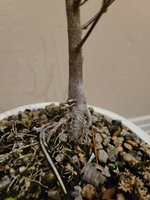Hi,
Fairly new to bonsai and my first post here.
I received a trident maple from Brussel's Bonsai that is very small. It came in a bonsai pot and has some aerial roots that are only about 1" above the soil. I plan to prune the tree back pretty far and am considering putting it back into a growers pot. I would like some advice.
1. Should I put it back into a larger pot to gain some size? The pot it's in is pretty parge for the trunk diameter,
2. Should a trident maple have any aerial roots? I am thinking they could be made lateral
If not, do I need to ground layer it or can I just raise the soil?
The fist picture gives you an idea of size. The top of the tree is about 12" from the soil and the pot is about 10" long. The other two pics show the roots.
Thanks in advance!
Eric
Fairly new to bonsai and my first post here.
I received a trident maple from Brussel's Bonsai that is very small. It came in a bonsai pot and has some aerial roots that are only about 1" above the soil. I plan to prune the tree back pretty far and am considering putting it back into a growers pot. I would like some advice.
1. Should I put it back into a larger pot to gain some size? The pot it's in is pretty parge for the trunk diameter,
2. Should a trident maple have any aerial roots? I am thinking they could be made lateral
If not, do I need to ground layer it or can I just raise the soil?
The fist picture gives you an idea of size. The top of the tree is about 12" from the soil and the pot is about 10" long. The other two pics show the roots.
Thanks in advance!
Eric



